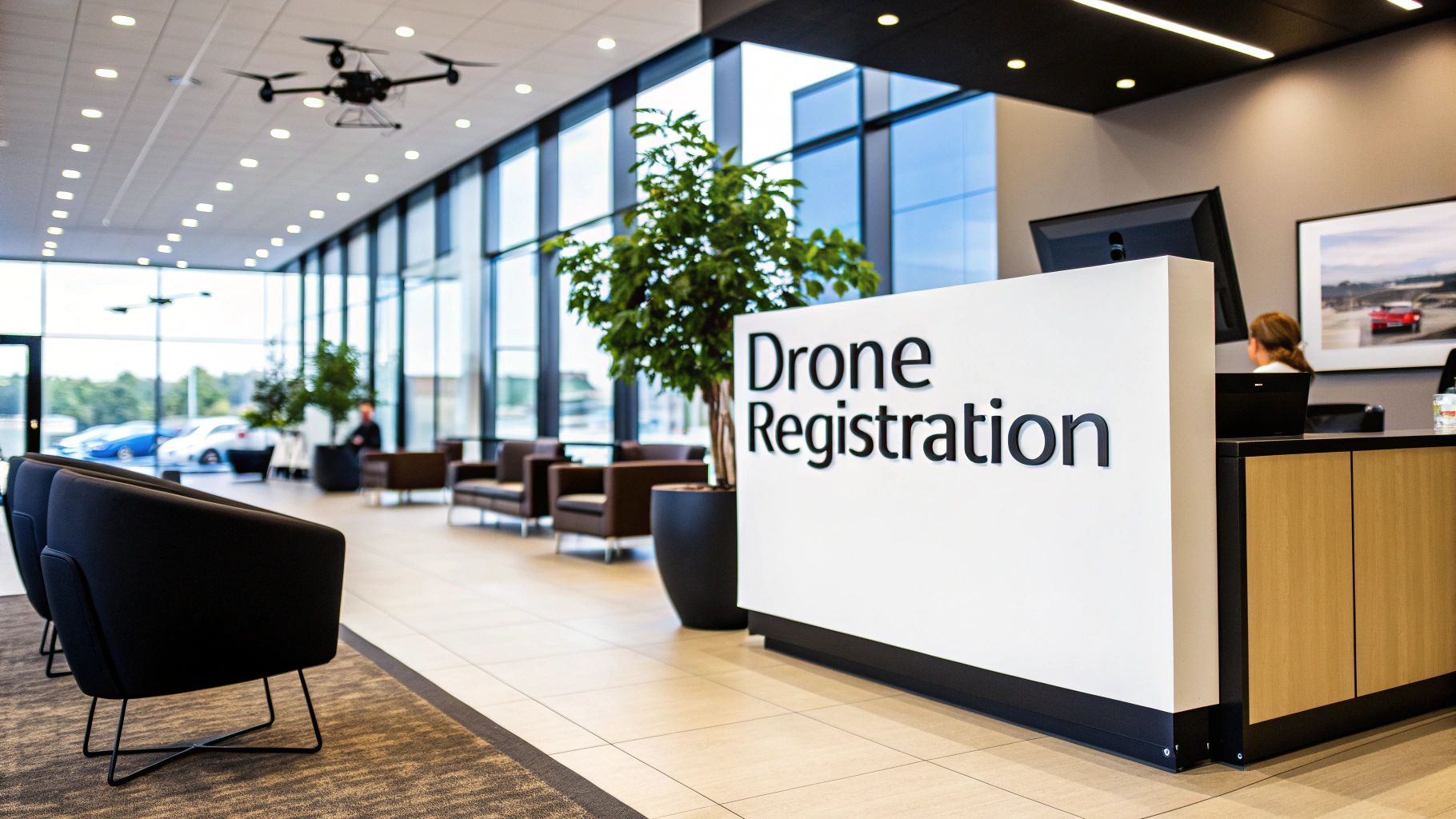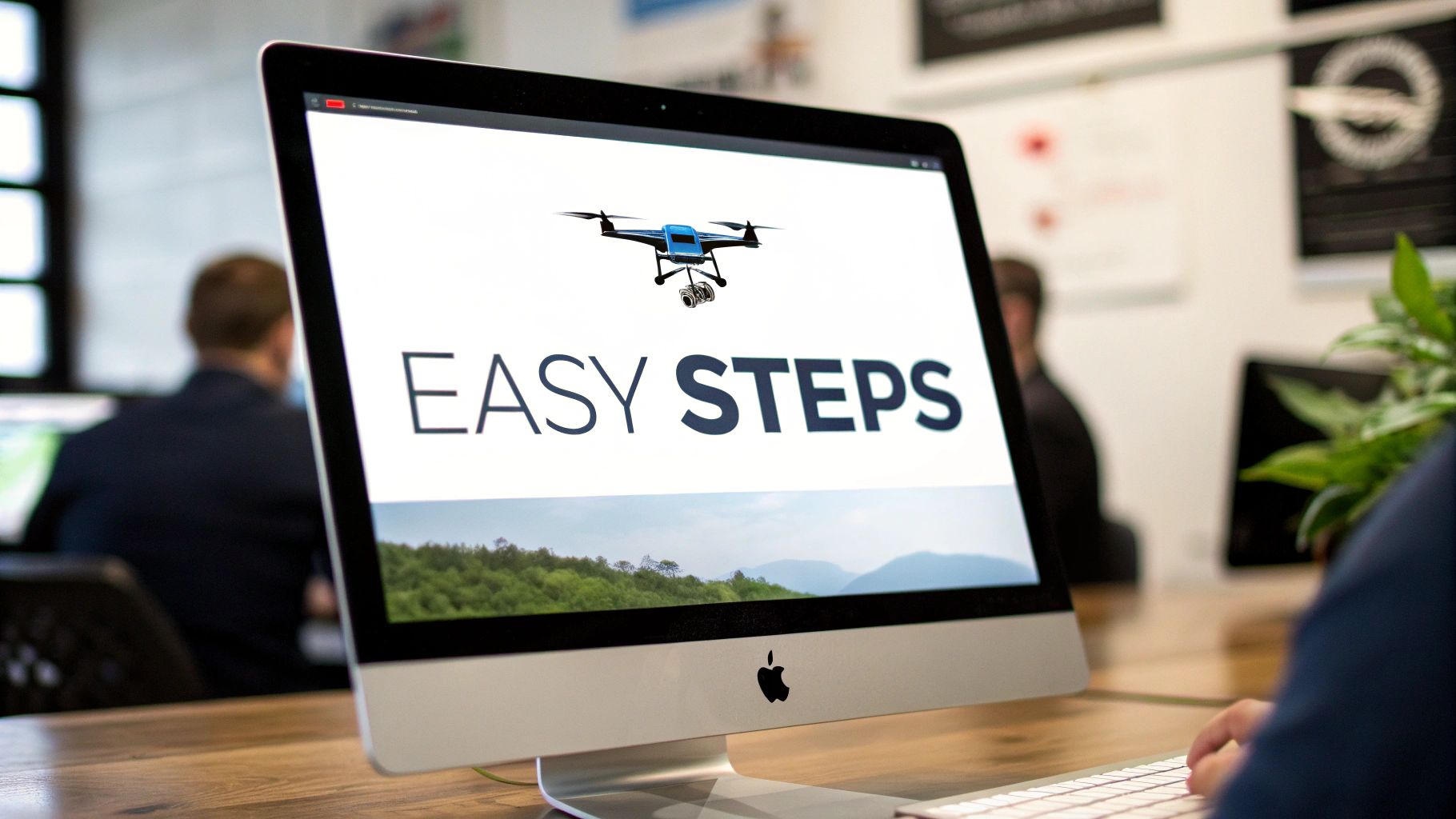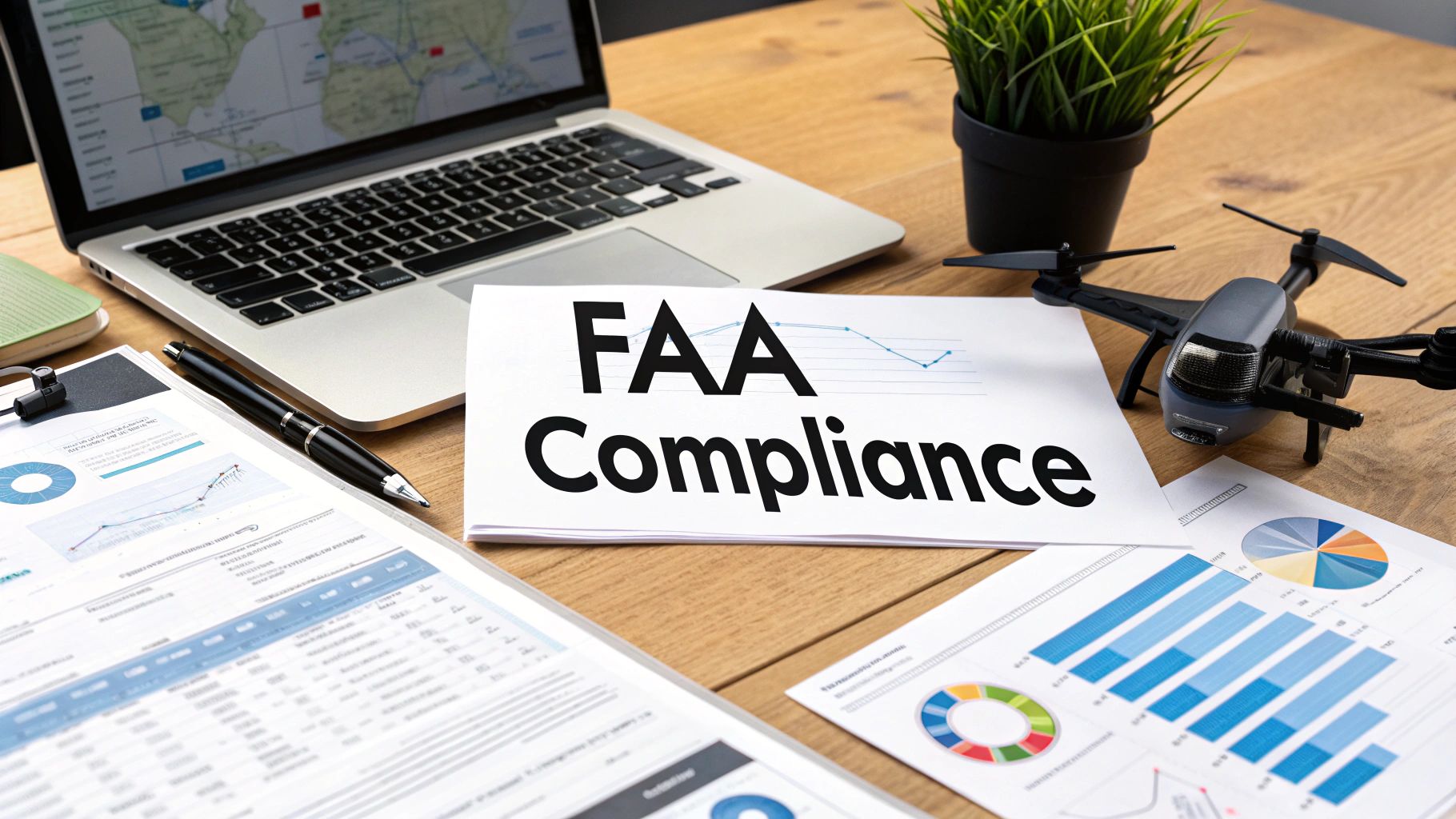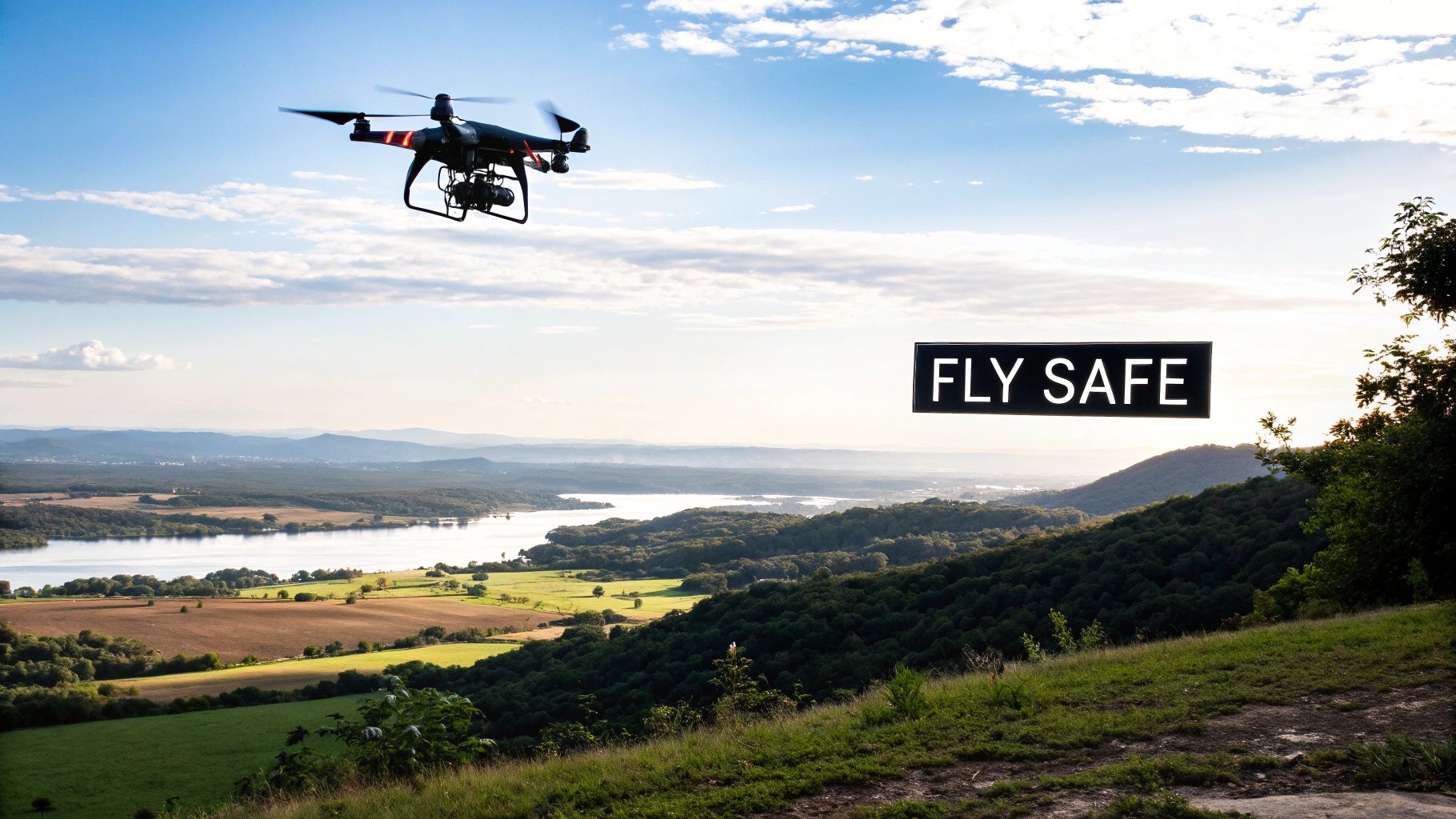FAA Drone Registration: Quick Guide
- Paul Simmons

- Apr 15
- 11 min read
Navigating FAA Drone Registration Requirements
Before taking to the skies with your drone, it's crucial to understand the surrounding airspace. Resources like a drone FAA map can be invaluable for this. Understanding FAA drone registration is essential for safe and responsible drone operation across the U.S. But who needs to register? The answer depends on whether you're flying for fun or profit.
Recreational Vs. Commercial Registration
The FAA differentiates between recreational and commercial drone use, each with its own registration process. Recreational flying generally has a simpler, less expensive process. However, even hobbyists must register if their drone weighs over 0.55 pounds (250 grams). This weight threshold applies regardless of where you plan to fly.
Commercial drone pilots, operating under Part 107 regulations, must register any drone used for business, irrespective of weight. Commercial use encompasses activities like aerial photography, infrastructure inspections, and package delivery. For commercial operators, FAA registration is tied to the Remote Pilot Certificate.
Exemptions and Legal Foundations
While the rules are generally straightforward, exceptions exist. Drones weighing under 0.55 pounds are exempt from registration, regardless of their intended use. This allows beginners and hobbyists with smaller drones to explore flight without complex regulations. Educational institutions participating in sanctioned programs may also have specific exemptions.
The legal basis for drone registration comes from the FAA Modernization and Reform Act of 2012. This legislation granted the FAA authority to regulate unmanned aircraft systems, paving the way for the current drone registration system, designed to enhance safety and accountability in U.S. airspace. By January 2018, over one million drones were registered – 878,000 recreational and 122,000 commercial, demonstrating the rapid adoption of drone technology. You can find more detailed statistics here.
Consequences of Non-Compliance
Failing to register your drone when required can have significant consequences, including civil penalties up to $27,500. In some cases, criminal penalties may also apply. Beyond fines, flying an unregistered drone poses safety risks. Unregistered drones are harder to track, increasing the potential for mid-air collisions or interference with other aircraft.

The FAA Drone Registration Process Demystified

Now that we understand who needs to register, let's explore the process. This section provides a clear guide to FAA drone registration, simplifying each step from beginning to end.
Creating Your DroneZone Account
The DroneZone is your central hub for FAA drone registration. It's essentially the DMV for drones. You'll create an account with basic information: name, address, and email. Recreational flyers will complete their entire registration here. Commercial pilots will use DroneZone along with the IACRA system for their Part 107 certificate.
Gathering Required Information
Before you begin, gather the necessary information to avoid delays. This includes your drone's make, model, and serial number. Having this ready streamlines the process. Also, have your credit card ready for the registration fee.
Step-by-Step Registration Guide for Recreational Flyers
Recreational drone registration with the FAA is simple. Here's a step-by-step guide:
Log into DroneZone: Access the FAA DroneZone portal and sign in.
Select "Recreational UAS Registration": Choose the correct registration type.
Provide Drone Information: Enter the required drone details: make, model, and serial number.
Pay the Registration Fee: The fee is $5, valid for three years.
Receive Your Registration Certificate: You'll receive a digital certificate. Print a copy to carry during flights.
Registering Multiple Drones Under One Account
If you have multiple recreational drones, one registration covers all of them. This simplifies management. Just ensure each drone displays the same registration number.
The Commercial Drone Registration Process (Part 107)
Commercial operators have a different process. After obtaining a Part 107 Remote Pilot Certificate through IACRA, they register their drones in DroneZone. This two-step process ensures both pilot certification and aircraft documentation. For further information on the Part 107 process, check out our guide on How to master....
To help illustrate the differences, let's look at a comparison table:
FAA Drone Registration Requirements Comparison
A comprehensive comparison of recreational vs. commercial drone registration requirements, fees, and renewal periods.
Requirement | Recreational (Part 48) | Commercial (Part 107) |
|---|---|---|
Registration Location | DroneZone | DroneZone (after obtaining Part 107 certificate through IACRA) |
Certificate Required | None | Part 107 Remote Pilot Certificate |
Fee | $5 | $5 |
Renewal Period | 3 years | 3 years |
Number of Drones Covered | All recreational drones owned by the registrant | All commercial drones owned by the registrant |
Key takeaway: While both recreational and commercial registrations cost the same and last for the same duration, commercial pilots must first obtain their Part 107 license.
Expediting Your Approval and Troubleshooting
While the FAA aims for efficiency, delays can happen. To speed up approval:
Double-check your information: Accuracy prevents processing errors.
Use clear photos for drone marking: Your drone's registration number must be clearly visible.
Keep records of your application: Documentation helps resolve potential issues.
If problems arise, the FAA provides online resources and support. Recovering a lost registration number, for instance, is often simpler than you might think.
This guide should help you navigate the FAA drone registration process, ensuring compliance for legal flight.
Recreational Vs. Commercial: Making The Right Choice
Choosing between registering your drone for recreational or commercial use is crucial. A wrong decision can lead to legal issues. It's not simply a matter of checking a box; it's about understanding the core differences between hobbyist flying and professional drone operations.
Defining Commercial Drone Use
The Federal Aviation Administration (FAA) defines commercial drone operation based on whether you receive any compensation for your flights. This compensation isn't limited to money. It includes anything of value, such as bartering services or even gaining social media followers for your business. For example, a real estate agent using drone footage to promote properties, even without directly charging for the drone service, is engaging in commercial use because it benefits their business.
Recreational Drones: Purely For Fun
Recreational drone use is purely for personal enjoyment. This includes flying for fun, taking personal photos, or exploring your neighborhood from above. Think of it like riding a bike – done for pleasure, not profit. You might be interested in: How to master...
The Part 107 Remote Pilot Certificate
Commercial drone operations require a Part 107 Remote Pilot Certificate. This certificate involves passing an FAA knowledge test, demonstrating a thorough understanding of airspace regulations, weather effects, and emergency procedures. It represents an investment in your skills and professionalism. This certification is not required for recreational flyers.
Legal Ramifications Of Incorrect Registration
Using a recreationally-registered drone for commercial purposes can result in significant fines. The FAA takes these regulations very seriously. As of March 2025, the FAA reported over 1 million drones registered, with 412,505 commercial registrations and 384,895 recreational registrations. These numbers emphasize the importance of proper registration in increasingly crowded airspace. More detailed statistics are available here. For instance, a photographer capturing images of a construction site for a client without a Part 107 certificate is committing a violation, regardless of how small the job may seem.

Real-World Examples
Several examples highlight the distinctions between recreational and commercial drone use. Posting drone photos on social media for fun is recreational. Using the same photos to attract clients to your photography business makes it commercial. Similarly, flying your drone for fun is recreational, but using it to inspect roofs for payment becomes a commercial activity. These seemingly minor differences carry major legal implications. Carefully consider the purpose of each flight before taking off. By understanding these distinctions and following FAA regulations, you can ensure you're flying safely and legally.
Managing Registration Costs and Renewals
Maintaining your FAA drone registration isn't a one-time thing. It requires keeping up with renewals and associated costs. This section will guide you through the process, ensuring you can continue flying legally.
Understanding Fee Structures
Currently, both recreational and commercial drone registrations have a $5 fee. This fee covers a three-year period. Payment is usually straightforward, accepting credit or debit cards through the DroneZone portal. For commercial operators, these fees are often considered business expenses and might be tax deductible. Consult with a tax professional for advice specific to your situation.
Renewal Timelines and Notifications
The FAA drone registration has a three-year renewal cycle. It's easy to let your registration lapse accidentally. To prevent this, set reminders on your calendar or use DroneZone's notification system. This keeps you flying legally.
The Renewal Process: A Step-by-Step Guide
Renewing your FAA drone registration is easy:
Log into DroneZone: Access your DroneZone account.
Navigate to your registration: Find your current drone registration info.
Verify your information: Confirm your drone and contact details are correct.
Pay the renewal fee: The fee remains $5.
Receive your updated registration: You'll get a new digital certificate valid for three more years.
Handling Expired Registrations and Late Renewals
If your registration expires, you can't fly until you renew it. While there might be a grace period, it's best to renew on time. The FAA offers guidance on handling expired registrations, including reinstatement procedures and fees.
Updating Your Information
It's essential to keep your contact information current. Update your address, email, or phone number in DroneZone if they change. This ensures you receive important notifications and stay compliant with FAA regulations. Updating your profile is usually simple.
To get a better understanding of the drone market in the U.S., let's take a look at some FAA drone registration statistics.
The following table provides a snapshot of drone registrations.
FAA Drone Registration Statistics and Growth
Year | Total Registrations | Recreational Registrations | Commercial Registrations | Growth Rate |
|---|---|---|---|---|
2020 | 1,721,924 | 1,258,074 | 250,058 | - |
2021 | 1,910,900 | 1,381,796 | 297,738 | 10.97% |
2022 | 2,167,721 | 1,539,702 | 363,999 | 13.44% |
2023 | 2,433,185 | 1,671,111 | 445,612 | 12.24% |
2024 (Projected) | 2,749,201 | 1,832,245 | 508,752 | 13.00% |
Data source: Statista. Numbers rounded for readability. Growth rates represent year-over-year change.
As shown in the table above, registrations are continuing to grow. As of September 2024, about 390,000 commercial drones and 389,000 recreational drones are registered, showing fairly balanced growth in both sectors. You can find more detailed drone registration statistics here.

By understanding these ongoing responsibilities, you can keep your FAA drone registration valid and continue safe and legal drone operations.
Marking Your Drone: Beyond the Basics
Marking your drone with your FAA registration number is more than just a compliance requirement. It's about protecting your investment and demonstrating your professionalism. This means understanding how to display your registration number so it can withstand regular use and different weather conditions.
Material-Specific Approaches
Different drone materials call for different marking methods. For plastic drones, durable labels or stickers designed for outdoor use are a good choice. Engraving can also be effective for certain types of plastic. For metal drones, engraving or a metal etching pen is usually the best option for a permanent mark. With composite materials, carefully research the drone's specific composition before selecting a method. It's always a good idea to test a small, hidden area first to ensure compatibility and prevent damage.
Creative Solutions for Smaller Drones
Smaller drones present a unique challenge because of their limited surface area. But with a little ingenuity, you can overcome this obstacle. Think about using a small label on the battery compartment or inside a landing gear leg. The most important thing is that the number remains clearly visible for inspection. Some pilots use high-contrast, permanent markers on the underside of the drone arms. This maximizes visibility without affecting the drone's aesthetics.
Placement and Aesthetics
Where you place your FAA registration number is also important. The FAA requires it to be readily accessible for inspection, but you should also consider placement that complements your drone’s design. Avoid placing it over sensors or vents, as this could interfere with their function. A clean, professional appearance builds confidence and helps avoid unwanted attention. You might also be interested in: Our sitemap for more information.
Common Marking Mistakes to Avoid
A few common errors can lead to non-compliance. One major mistake is using easily removable tape. The registration number needs to be permanently attached. Another frequent oversight is using a font size that's too small to read easily. Make sure the numbering is clear and stands out. Also, avoid placing the number where it could be easily covered by dirt or debris. Regularly check your drone to ensure the marking remains clean and visible.
Durable and Design-Conscious Techniques
A properly marked drone shows a pilot’s dedication to responsible operation. Laser engraving, if suitable for the material, offers exceptional durability. If you choose labels, select high-quality, UV-resistant options designed to withstand the elements. Thoughtful placement, a legible font size, and regular maintenance contribute to a professional look and ensure your drone complies with FAA requirements. By following these best practices, you can ensure your drone stands out for all the right reasons, both in the air and during inspections.
Troubleshooting FAA Drone Registration Roadblocks
Registering your drone with the FAA is usually pretty simple, but sometimes you might hit a few snags. This section offers solutions to common registration problems, helping you get back in the air quickly.
Resolving Payment Processing Errors
It can be frustrating to have your payment declined after entering all your information correctly. This can happen for several reasons, like incorrect card details, insufficient funds, or security flags from your bank. Start by double-checking your card information.
If the problem continues, contact your bank. They can verify that the transaction isn't blocked. Some banks flag unusual online purchases as potentially fraudulent. You might need to authorize the transaction with your bank. If your bank says everything is fine, try using a different card or payment method.
Recovering Lost Registration Numbers
Losing your drone registration number can feel like a major setback, but recovering it is usually straightforward. Simply log into your DroneZone account. Your registration information, including your number, should be available in your profile.
This saves you from having to complete a new application. If you can't access DroneZone, contact the FAA directly.
Addressing Application Errors
Sometimes, errors pop up during the application itself. Maybe you missed a required field, or there’s a technical glitch on the website. Carefully review any error messages. They often tell you exactly what’s wrong.
For example, if you see an error about an invalid serial number, double-check your drone's documentation. Also, make sure you're using a compatible browser. Older browsers can sometimes have trouble with the DroneZone platform.
Contacting the FAA Directly
If you keep running into problems, don't hesitate to contact the FAA. Online resources are great, but sometimes talking to a person is the best way to solve a tricky problem. The FAA provides phone numbers and email addresses for support.
They can help you with specific issues, like registering a damaged drone or transferring ownership.
When to Seek Professional Assistance
Most registration issues are easy to handle on your own. But sometimes, professional help is a good idea. If you’re dealing with a complicated situation, such as registering a heavily modified drone, a drone lawyer or consultant can provide expert guidance.
They can help you understand the regulations and make sure you’re meeting all the requirements. This is especially important for commercial operators who need to follow specific Part 107 requirements.
Special Circumstances: Damaged Drones and Ownership Transfers
Registering a damaged drone needs extra care. You’ll need to document the damage and accurately record all remaining identifiable information. Transferring ownership also requires the right paperwork, like a bill of sale, and updating the registration in DroneZone. This ensures a smooth transition and avoids problems down the road. For a large drone weighing over 55 lbs, you'll need to follow a more complex registration process, which involves mail-in forms and specific documentation required by the FAA.
By following these troubleshooting tips and knowing when to ask for help, you can overcome those FAA registration roadblocks and be ready to fly legally and responsibly.
Beyond Registration: Your Complete Compliance Picture
FAA drone registration is essential, but it’s only one part of the broader regulatory landscape. Understanding how your registration interacts with other rules is crucial for safe and legal flying.
LAANC Authorization and Your Registration
Your registration status directly impacts your ability to access controlled airspace. The Low Altitude Authorization and Notification Capability (LAANC) system allows drone pilots to get near-instant authorization to fly in certain controlled airspaces. However, you need a valid FAA drone registration before applying. It's similar to needing a driver's license before applying for a special permit. Without registration, LAANC access is impossible.
Remote ID and Registration: A Connected System
Remote ID, a newer requirement, mandates that drones broadcast identifying information during flight. This includes the drone's registration number, location, and other key data. This connection underscores the importance of accurate and current registration information. Remote ID links your drone's real-time flight data to your registered identity, ensuring accountability and transparency.
Part 107 Waivers and Registration
For commercial operators, proper FAA drone registration is essential for obtaining Part 107 waivers. These waivers grant permission to operate outside standard Part 107 rules, such as flying at night or over people. A good registration record shows your dedication to compliance and can improve your chances of waiver approval. Violations or an expired registration can hinder your waiver application.
State and Local Regulations: Adding Another Layer
Beyond federal regulations, state and local laws can add complexity. Some states require extra permits for commercial drone operations, even with an FAA Part 107 certificate. Cities may have ordinances restricting drone flights in parks or near sensitive areas. These local regulations vary, so research the specific rules in your area before you fly. This helps you stay compliant at every level, avoid legal problems, and maintain positive community relations. Ignoring local rules can lead to penalties and jeopardize your flying privileges.
Understanding the complete compliance picture, from FAA registration to local rules, lets you navigate drone regulations confidently and legally.
Ready to elevate your drone operations? JAB Drone offers expert insights, product reviews, and the latest news in unmanned aerial vehicles. Visit JAB Drone today!




Comments